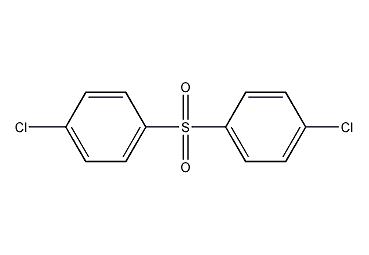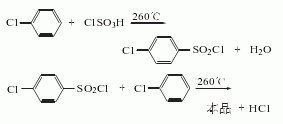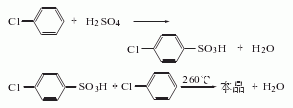
Structural formula
| Business number | 01QH |
|---|---|
| Molecular formula | C12H8Cl2O2S |
| Molecular weight | 287.17 |
| label |
Bis(4-chlorophenyl)sulfone, Bis(4-chlorophenyl) sulfone, aromatic sulfur compounds |
Numbering system
CAS number:80-07-9
MDL number:MFCD00000619
EINECS number:201-247-9
RTECS number:WR3450000
BRN number:2052955
PubChem number:24849123
Physical property data
1. Properties: rhombohedral crystals
2. Density (g/mL, 25/4℃): Undetermined
3. Relative density: 1.54
4. Melting point (ºC): 146~149
5. Boiling point (ºC, normal pressure): Undetermined
6. Boiling point (ºC, 5.2kPa): Undetermined
7. Refractive index: Undetermined
8. Flash point (ºC): Undetermined
9. Specific rotation (º): Undetermined Determined
10. Autoignition point or ignition temperature (ºC): Not determined
11. Vapor pressure (kPa, 25ºC): Not determined
12. Saturated vapor pressure (kPa, 60ºC): Undetermined
13. Heat of combustion (KJ/mol): Undetermined
14. Critical temperature (ºC): Undetermined
15. Critical pressure (KPa): Undetermined
16. Log value of oil-water (octanol/water) partition coefficient: Undetermined
17. Explosion upper limit ( %, V/V): Undetermined
18. Lower explosion limit (%, V/V): Undetermined
19. Solubility: Insoluble in water, slightly soluble in cold Ethanol can be sublimated.
Toxicological data
1. Rat caliber LD50: 7500mg/kg; mouse caliber LD50: 24mg/kg
2. Other multi-dose toxicity data
Rat caliber TDL0: 364mg/ kg/26W-I
Ecological data
None yet
Molecular structure data
1. Molar refractive index: 69.93
2. Molar volume (cm3/mol): 201.6
3. Isotonic specific volume (90.2K ): 531.3
4. Surface tension (dyne/cm): 48.1
5. Polarizability (10-24cm3): 27.72
Compute chemical data
1. Hydrophobic parameter calculation reference value (XlogP): 3.9
2. Number of hydrogen bond donors: 0
3. Number of hydrogen bond acceptors: 2
4. Number of rotatable chemical bonds: 2
5. Topological molecular polar surface area (TPSA): 34.1
6. Number of heavy atoms: 17
7. SurfaceCharge: 0
8. Complexity: 306
9. Number of isotope atoms: 0
10. Determine the number of atomic stereocenters: 0
11. Uncertain number of atomic stereocenters: 0
12. Determined number of chemical bond stereocenters: 0
13. Uncertain number of chemical bond stereocenters :0
14. Number of covalent bond units: 1
Properties and stability
Low toxicity, chlorobenzene used in the production process is a highly toxic substance, which is highly irritating to the skin, eyes, nose and respiratory system. Chlorosulfonic acid is more toxic and irritating. Therefore, attention must be paid to the tightness of the equipment during the production process to prevent leakage. Good ventilation should be maintained at the production site, and operators should wear protective equipment.
Storage method
This product should be kept sealed.
Packed in iron drums lined with plastic bags, 35kg per drum. Store in a dry, ventilated place, away from sunlight, heat and moisture. Store and transport according to general chemical regulations
Synthesis method
1. Chlorosulfonic acid method: Use chlorobenzene and chlorosulfonic acid to react to prepare 4-chlorobenzenesulfonyl chloride, which is then condensed with chlorobenzene in the presence of aluminum trichloride and refined to obtain the finished product. 
2. Sulfuric acid method: Using industrial sulfuric acid and chlorobenzene as raw materials, the product is synthesized by batch method or continuous method. The reaction is carried out in the presence of excess chlorobenzene.

Purpose
1. It is the main raw material for manufacturing engineering plastics such as polysulfone and polyethersulfone; it is also an intermediate for medicines, dyes and pesticides, and is widely used in the fields of engineering plastics and fine chemicals.
2. This product is the main intermediate of engineering plastic polysulfone. Used in organic synthesis and drug synthesis, such as the synthesis of 4,4’-diaminodiphenyl sulfone, a drug for treating leprosy.

 微信扫一扫打赏
微信扫一扫打赏

